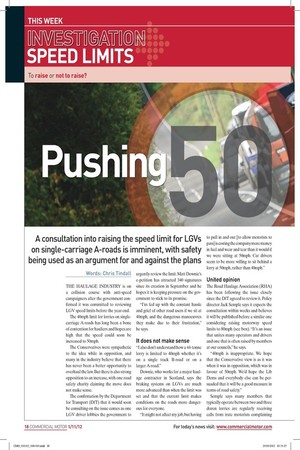Pushing
Page 13

Page 14

If you've noticed an error in this article please click here to report it so we can fix it.
A consultation into raising the speed limit for LGVs on single-carriage A-roads is imminent, with safety being used as an argument for and against the plans
Words: Chris Tindall
THE HAULAGE INDUSTRY is on a collision course with anti-speed campaigners after the government confirmed it was committed to reviewing LGV speed limits before the year-end.
The 40mph limit for lorries on singlecarriage A-roads has long been a bone of contention for hauliers and hopes are high that the speed could soon be increased to 50mph.
The Conservatives were sympathetic to the idea while in opposition, and many in the industry believe that there has never been a better opportunity to overhaul the law. But there is also strong opposition to an increase, with one road safety charity claiming the move does not make sense.
The confirmation by the Department for Transport (DfT) that it would soon be consulting on the issue comes as one LGV driver lobbies the government to urgently review the limit. Matt Downie’s e-petition has attracted 340 signatures since its creation in September and he hopes it is keeping pressure on the government to stick to its promise.
“I’m fed up with the constant hassle and grief of other road users if we sit at 40mph, and the dangerous manoeuvres they make due to their frustration,” he says.
It does not make sense
“I also don’t understand how a 44-tonne lorry is limited to 40mph whether it’s on a single track B-road or on a larger A-road.” Downie, who works for a major haulage contractor in Scotland, says the braking systems on LGVs are much more advanced than when the limit was set and that the current limit makes conditions on the roads more dangerous for everyone.
“It might not affect my job, but having to pull in and out [to allow motorists to pass] is costing the company more money in fuel and wear and tear than it would if we were sitting at 50mph. Car drivers seem to be more willing to sit behind a lorry at 50mph, rather than 40mph.”
United opinion
The Road Haulage Association (RHA) has been following the issue closely since the DfT agreed to review it. Policy director Jack Semple says it expects the consultation within weeks and believes it will be published before a similar one considering raising motorway speed limits to 80mph (see box). “It’s an issue that unites many operators and drivers and one that is often raised by members at our councils,” he says.
“40mph is inappropriate. We hope that the Conservative view is as it was when it was in opposition, which was in favour of 50mph. We’d hope the Lib Dems and everybody else can be persuaded that it will be a good measure in terms of road safety.” Semple says many members that typically operate between two and three dozen lorries are regularly receiving calls from irate motorists complaining about the speed their drivers were travelling at. “It’s simply too slow on a lot of A-roads,” he explains. “50mph may be inappropriate to all stretches of singlecarriage A-roads, but there are a good many where it is appropriate.”
Normalising speed
The Freight Transport Association (FTA) prefers to use the phrase “normalising the speed between cars and trucks” and explains that it’s the difference between the limits of various classes of vehicles that causes problems.
“That’s the issue. It’s the dangerous situation created because trucks are limited to 40mph and cars want to overtake them, sometimes in very dangerous situations,” says FTA head of road network management policy Malcolm Bingham.
“A lot of lorries already do 50mph anyway, simply because they get hassle from car drivers if they don’t. It seems sensible to try and normalise the speeds.” However, while the haulage industry is largely united on the issue, there are still several objectors.
Road safety charity Brake argues that other solutions need to be relied on to tackle dangerous overtaking. “It does not make sense to attempt to address this problem through a step that would bring heightened risks,” says a spokeswoman for the charity.
“There is a clearly evidenced and direct link between speed and safety: put simply, faster traffic speeds mean more crashes and more serious crashes. It’s particularly important that speed is managed and limited for large CVs, which take longer to stop and have a greater force of impact if they crash,” she adds.
Dr Will Murray, research director at Interactive Driving Systems, which provides fleet risk management products, was opposed to the idea eight years ago when CM ran a campaign to get the limit increased. His opinion is unchanged. “Raising speed limits is not a good idea for safety, it’s not a good idea for business costs and it’s not a good idea for fuel efficiency.
Sharing the road
“Sharing the road is still a key issue on all road types, but particularly single carriageways – generally truck drivers are pretty good, and their behaviour is important. I still see too many other road users not understanding how to share the road with trucks.” ■











































